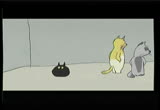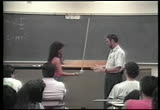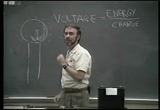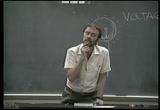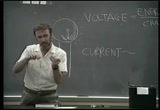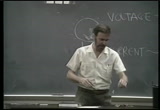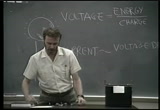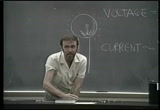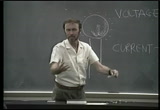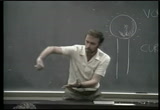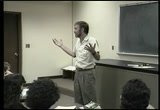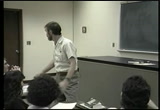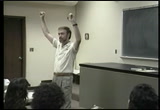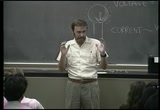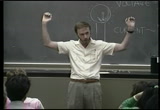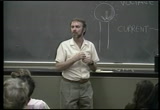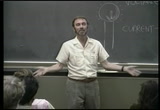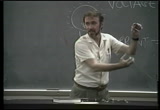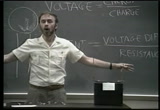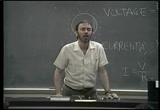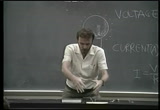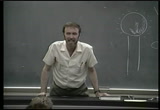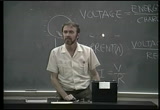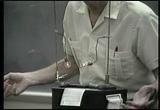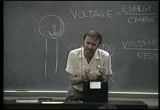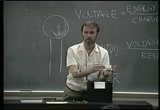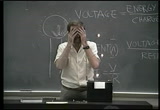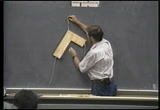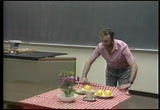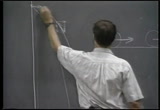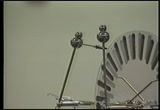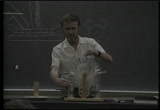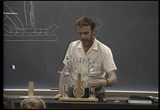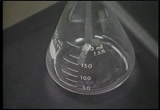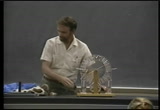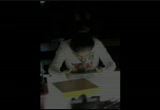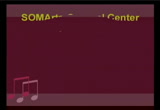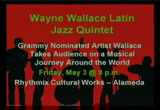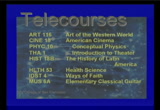tv Democracy Now LINKTV April 16, 2013 8:00am-9:00am PDT
8:01 am
okay, let's begin. last time, we had the van de graaff generator, gang. and we talked about... we talked about lighting up a lamp. remember i had this lamp and i held it like this, and the lamp lit, and held it like this and it didn't light. surrounding that dome is an alteration of space. and that space is said to contain an electric field, a force field. and you can tell 'cause when you walk by this, you can feel your hair stand up a little bit on that. space is different with all that charge there. and it turns out the force field is stronger in here and weaker, weaker as you go further and further away. in fact, it behaves as an inverse square law, when you have all your charge localized at one place like this. it keeps petering out with the inverse square of distance, just like gravity does. and when i held the lamp like this, it lit. you know why? that's because this part here was in the stronger part of the force field than here.
8:02 am
we say that there's more energy on the charges here than here, which introduces a concept, i wanna see if you can get into, the idea of energy per charge, and we call that voltage. let me define that. energy per charge. that'd be energy in joules compared to charge. and do you know what the unit of charge is? - coulomb. - coulomb. so one joule per one coulomb is said to be an electrical pressure of one volt. so that's what voltage is, energy per charge. we saw the dome was charged up to thousands of volts. so trisha touched that thing, thousands of volts. why wasn't trisha zapped? well, she zapped a little bit, but why is she still here today?
8:03 am
enormous amount of energy per charge, okay? but not very many charges. if trisha went home tonight and took a bobby pin and stuck into 110 volts at home, honey, trisha wouldn't be here next time maybe, yeah, okay? she'd be hurt. you know why? that's not so much energy per charge. but how many charges are gonna flow when you stick into the power company socket, a lot or a little? it begins with a l. - a lot. - a lot. so there might be a little energy per charge, but so many that total energy going through you is very uncomfortable. but the energy that came from the van de graaff generator, a lot of energy per charge, but if not many, many charges, then not much total energy. it's very similar to high temperature and low temperature. remember we talked about the fourth of july sparkler that's got temperature more than a thousand degrees? but you don't get burned by the spark, because why? although the energy per molecule is very high,
8:04 am
you don't have very many molecules in the spark. so the total energy is below the threshold of feeling. so very, very similar. this idea of something per something else, gives sometimes counterintuitive type of things. that you could touch a van de graaff generator with enormous voltage without harm, that you can have a spark touch you of enormous temperature without harm. it's because it's the energy per something else. do you kind of see that? now, what happened over here? why the current flowed had to do with the idea more electrical pressure on one side than the other. and so the flow of current... is proportional to voltage difference. not how much voltage, but how much voltage in one place compared to the other. think of voltage as a pressure, huh? so it's proportional to voltage difference.
8:05 am
proportional to. so the more voltage difference, the more-- hey, imagine i have a pipe right here filled with water. okay? see that water filled pipe? i have a piston over here, and i have a piston here. and i push with a certain pressure, maybe five units. i push with the same pressure here, five units. which way does the water flow? how many say the water isn't gonna flow at all? i say, "yeah, they're under pressure." and you say, "yeah, but there's no pressure... - ...difference. - ...difference. how about i push here with five and i push over here with three. what does the water do, gang? what does the water do? the water flows, okay? and similar, you take a piece of wire and you put a pressure difference across the wire, and i can do that here. here's a lamp, okay? this is a 12-volt battery. one end is 12 volts higher than the other. if i touch here and touch here, no light. no light, yeah. if i touch here and touch here, no light. this 12 volts, 12 volts, why no light?
8:06 am
check your neighbor why no light. let's try the other side. no light. and still no light. why--how come? no difference. but i got zero volts over here. i mean, i got 12 volts. there's no difference-- you got to have difference. what will happen if i go like this? hey, hey, hey. ought to be, huh? what's the voltage difference across the lamp now? - 12. - 12. 12. so if you got a voltage difference, you get a current. it kinda makes sense. this is not counterintuitive. the more voltage difference you have, the more current you're gonna have through a conductor. and this is a conductor. it's a piece of wire made up of copper with-- a lot of electrons can flow all through there, gang. so i have a conducting path with a voltage difference. no voltage difference, no current at all. voltage difference for a current, makes sense? you know, when i was a little kid, i've learned about some of this stuff at least from a neighbor. across the street was a guy that used to fix his car all the time. and he was a little older than us. and he kinda taught us kids a lot of things. and he'll be fixing the car and be under there
8:07 am
doing electrical work and everything. and i noticed that what he'd do is he'd put his hand behind his back when he's kinda fooling around. there's a coil in there, high voltage, more than a thousand volts, coil, induction coil, okay? and what he do, he fooling around with that. he makes sure one hand behind here. "hey, hey, jack, how come you put your hand behind there, man?" he said, "i put my hand behind here, "because i don't wanna touch a high voltage, "and have my other hand over here on the car "'cause then the voltage would between this hand and this hand." and guess what's in between? begin with h. - end with eart. heart. try it. your heart. and how many say, "oh, i like to have current flowing through my heart? who? come on, no way. you don't want the current to go through your heart. that's the worst thing. and so as long as he touches like this, then the current might go from here... [whistles] ...right down the foot. oh, he'll be hurt, but it don't go through here. you don't want it going across your heart. another thing he always did too. he told us about this. when you touch a wire-- a lot of times, people touch a wire and... [grunts] --they get, ah, and they can't let go. do you know why they can't let go? oh, they're attracted to the electric--
8:08 am
no, he isn't attracted-- contraction. remember the biology experiment you do to frog's legs, the frog leg like that? and you come over and you touch like that. the frog is dead, honey, and it's still going like that. it turns out that electric-- can you guys do that? try it. i hope you can. do you know what you guys are doing? you are sending electrical impulses down your hand. it's electrical impulses who do that. and it contracts. so what happened when you touch the wire? [grunts] it's not that you're attracted is that your fingers contract. so he told us that electrician types always, if they're fooling around, they touch like this. they touch, like, and try to get to pull away, see? you're okay. but you don't wanna go like that. you know what i'm saying? practical stuff. anyway, you want to avoid voltage differences. hey, why is it that you see birds on high-tension wires, bare wires, and you see the bird come down and he grab on the foot and stand on one foot and he's on the wire. and the bird doesn't get fried, the bird's okay.
8:09 am
now what happened? the bird reach down and put the other foot on the same wire, what happened to the bird then? begin with n, end with othing. try it. - nothing. - nothing. bird's okay. hey, man, the bird is at 100,000 volts. is the bird all right? yeah. the bird is all right because he got-- what's the voltage difference across the bird? none. zilch. zilch. let me tell you what i used to do when i was a kid. i grew up in the suburbs of boston. and we used to go in and visit boston. and sometimes we'd go to the mta, metropolitan transit authority. it's the underground train, electrified. the train rides into two rails, and there's a third rail. and guess what the third rail is for, gang? it's 5,000 volts. that's the source of energy. now the third rail is a little higher. and what the train does, it has a little brush all the time scraping. and so it gets 5,000 volts between that brush and the rail, see? 5,000 volts runs your motor, and these things are motor-driven, electrified rails. well, we kids, we used to do something that, looking back, i'm not so proud of it.
8:10 am
but let me tell you what we used to do. we used to get on the rail there. we'd get up in there, okay? we'd be in the platform and the trains are coming by here. now, what we would do-- and we found out that we could get the people on the platform very excited-- we jump down on the pit. and we jump down-- you're not supposed to do that. [laughter] but they got a white line here. but we would do it anyway. and we found when we did it, the adults up there would freak out. now, you would think that if they're freaking out and concerned, we would say, "wait a minute. we're upsetting the adults. let's get back up." but we didn't. the more they got upset-- some people think that little kids are innocent, innocent, innocent. and as you get older and older, you get more and more corrupted. there's a case to be made, it's the other way around, okay? that as you get older and older, hopefully, you get developed and start to think about other people. but when you're a little kid, you don't kinda do that. but anyway, we used to do that, and we used to play a game. and see, when a train would come, we'd jump up and let the train go right by. and we were good at it. besides you could smell the ozone as the train is coming up. and we always thought that we could smell better
8:11 am
than the other people. we could hear better than-- it turns out we could. and we were to play a game and see who's the last one to jump up when that train come by. well, the game cascaded. it went further than that, because we'd be walking on a rail like that putting our arms out. now i know why i put the arms out. you guys know why we put the arms out? balance. increases your rotational inertia, yeah, okay? we'd be on a rail like that, okay? and then jump at the other rail, boom, like that. and a lady at the top, she said, "oh, children," and she was identifying with us. we weren't identifying with her. now, who's more developed? "children, children, watch out for that third rail." "what are you talking about, lady? this one over here?" "yes, yes, watch out for that third rail, children." "this one lady?" hoomp. what's the voltage? it turns out 5,000 volts on this foot. what's the voltage on this foot? 5,000. 5,000 volts. what's the voltage difference across my body? zero. zip. what's the current flowing through my body? zip. who's okay? you are. i'm all right.
8:12 am
she's freaking. she don't know anything. [laughter] all right? one day, harry is on that third rail. he's going across that third rail. oh, harry, man, he was-- well, harry. and she said, "don't touch both rails at one time." he said, "what, like this, lady?" zap. at the funeral... [laughter] no, harry didn't really do that. but if he did do that, what happened? 5,000 and zero, boom, bam, honey, bad, bad scene, yeah. you don't wanna get a voltage difference. but with no voltage difference, you can do wonders, yeah. no voltage difference. you could be--you could fall out of a helicopter and, boom, hit a high-tension wire and you could hold on it. maybe it's 120,000 volts, boom, 120,000. what's over here? 120, yeah. oh, now, a miracle of miracles, i made it. well, now, i gotta get down. oh, i think i just go over here and grab the tower. [laughter] oh, no, no, don't grab the tower. what's gonna happen when you grab the tower? oh. no good.
8:13 am
you're gonna have a voltage difference. you know what i'm saying? yeah. hey, something happened in california sometime ago. well, this over 10 years now. you guys you know what a cherry picker is? it's a truck that's got a boom that goes way up and service the wires. well, it turns out, up near lake tahoe, they had a storm and some of the wires went out. they sent the cherry picker up. and the cherry picker went up there and repairing the wires and everything. all of a sudden, it slipped in the mud-- [grunts] --and shorted right against the wires. and the whole thing is more than 100,000 volts. the whole thing-- and there's a guy up there. and the guy is sitting in there, and guess what his potential is, what his voltage is? something like a hundred, maybe 120,000. he's the same high voltage, but he's okay, 'cause every part of his body, all right? now it turns out that you're not supposed to drink on the job. that he had been drinking beer. you people be knowing what happens after you drink some beer? what you gotta do?
8:14 am
he had to go to the bathroom. but there's no bathroom up there. now, he's certainly-- he's a well-- but he's not gonna go right in his own feet, right? so where did he go to the bathroom, so to speak? where did he relieve himself, gang? onto the ground. over the edge. right over the edge. guess what his last act was? [laughter] and you see why? you see, this is a true story. this is a true story. that guy might as well tied a piece of copper wire onto himself and throw the other end right down into the ground. because he afforded a conducting path from him, boom, he'd never know what hit him, never know. he made contact with the ground. so he's got 100,000 volts-- that's it. that's it. so when you're up there high and away there, honey, just hold on, okay? save it. this course may save your life someday, yeah? what happen if he had done one drop at a time? he would be okay, campbell, had he done one drop at a time. [laughter] or a little squirts, right? [laughter]
8:15 am
the poor dude never know-- he never helped in that... he should have known. can you imagine him now as an angel? "i saw a big flash. and it's too late." it's too late, yeah. another thing too. when i was in boston, the very first job i ever had when i got out of high school was--i was an errand boy. and as an errand boy, one time, i remember it was at everett, mass, and there the mta goes up on the top. they call it the elevated. you've seen it in the movies, you guys, right? and all the trains going by-- and it turns out that all these fire engines and everything were all around. and i was wondering, "what's all the excitement?" and it turns out that, lo and behold, there's a guy in the top, an indigent, better a name than for bum. in the middle of the winter is a guy sitting on the third rail, drinking his wine with his feet on the second rail. and everyone is freaking and the guy is okay. do you be knowing why the guy is okay? maybe the sole of his shoes.
8:16 am
let me give you a hint. it's winter time. oh, winter. he's poor. he can't afford nice thermal underwear and nice down parkas. so what does he use, gang? begin with p end with aper. paper. got our news in the front. newspaper. this guy was plastered with newspaper inside. guess what is a very good heat conductor. newspaper--oh, no, heat insulator. heat insulator. heat insulator, a newspaper, right? why is newspaper a good heat insulator? 'cause it doesn't have those loose electrons. and guess what is also a good electrical insulator for the very same reason. begin with n end with paper. try it. - newspaper. - newspaper. and this guy had a lot of newspaper, a nice insulator. and what he did is he effectively increased the electrical resistance between him and the tracks. and so this relationship, current, proportional to voltage difference, becomes an exact equation
8:17 am
when i include the idea of resistance. if you have a humongous resistance even for a big voltage difference, the current will be very small. so how much current flows through things? it has to do with two ideas, gang. what's the voltage difference across the ends-- for the conductor, and what's the resistance that that conductor offers to a current flow to begin with? and that usually has to do with the geometry and the material of the conductor. like a great big fat piece of copper has less resistance than a little skinny, skinny piece of copper. just like a great big, humongous pipe, will have less resistance to the flow of water than a little skinny, skinny pipe, yeah? and how about a lamp like this? this copper right here is relatively thick. but it's very, very thin in there where the filament is. guess where most of the resistance is across these two leads. begins with fil.
8:18 am
- filament. - filament. in that filament is most of the resistance. and guess where most of the energy is dissipated going from here to here when it touches across the battery, right in the filament. in fact, the filament reacts a little bit. it turns white hot with heat. look at that. it's glowing. and there's your lamp. isn't that nice? now you can read books and things at nighttime without having to kill whales, and just use a battery. isn't that nice, okay? a little-- you don't need a flame. just make that little piece of tungsten wire, it gets so hot, it'll glow. ain't that glowing? of course, there's your light. kinda neat, yeah? so we measure current in amperes, amps, okay? and we measure voltage in... volts. volts. and we measure resistance in... ohms. all together now. ohms. okay, there's a ohm. yeah, that's ohms. in fact, ohms are written like this. greek letter omega, ohm. voltage is written like this, v, and current is in n.
8:19 am
amps, the unit is amps. and oftentimes, we call current i. so we could say i equals v over r. and it's the old song and dance, gang, that if you know two of these things, you know the other. like, for example, let's suppose i tell you, the resistance of this little lamp is one ohm. and i put it across this 12-volt battery. there are people in this room besides lee who can tell me how much current is going through the battery? and then there are people that can't. check to see if you're sitting next to someone who can. 1 ohm resistance, 12 volts across the battery. what's the answer, gang? 12. 12, and that's 12. that's ohm's law, ohm's law. ohm's law just gives us the relationship between current, the voltage and the resistance. kinda neat stuff. now, when i touch this like this, gang, i'm getting current that flows in one direction. goes from here to here or here to here, or i don't forget which is which, okay?
8:20 am
but it flows all in one-- we have a name for current that has one directional flow. guest what we call it, gang. direct. direct current, dc. to say you have dc current is to say you have current that flows in one direction. that doesn't mean it has to be steady, steady, steady, it could be pulsed. you go off, on, off, on or something like that. but always one direction through the wire. and then you have the kind of current that lights the lamps in the room here and at home. and the kind of current you have in your home, and what is that? alternating. it alternates back, forth, back, forth. we call the kind of current that alternates back and forth guess what. - alternating. - alternating current, ac, okay? and here's how the ac current works. you see this washing machine right here? see the washing machine agitator? i'm gonna put my clothes in here. can you see that? look at the motor underneath there, gang. notice all it is, it's a region that contains water and it's got a paddle like that. and notice that paddle is hooked up here. and i wanna make this thing go, that's what i wanna do, right? and notice down here, it's all water tight. and i get that paddle. notice these two leads, see, they're lucite--
8:21 am
you can even see right through them, okay? filled with water, yeah? see these two holes in the wall? watch this. that's the power company. i put it right in there. look in that hole, you know what you see? you see a couple of pumps like this. it's all i got. that's what the power company does, okay? so you put this in, okay, you connect it, boom, what's your water doing now? the water--do you see it? over here. what's it doing over here to the paddle? what's happened now? your washing machine, water power, hey, water power. helps you wash your clothes. we do the same thing without water. guess what you use instead of water, gang? begin with e. - electricity. - electrons. the electrons in a piece of copper wire. you can make those things slosh back and forth too. and you plug it in the plug in your house, and what do you do? what the power company does, it'll just move them. and by the way, did you catch in the chapter? how many electrons come from the power plant
8:22 am
to your house annually, about-- a lot or a little? a lot. answer don't begin with a l. what's the answer, gang? how many electrons come from the power company into your home in about one year, one year's time? give me an answer. - zero. - yeah, zero. none. the power company doesn't send any electrons at all to you. that power company says, "you give me something "chock-full of loose electrons, honey, and we'll make them move." see? that pipe that was filled with water, you gotta supply the water. you look inside there, honey, it's dry. there's just two pistons, okay? and they're gonna push the water you supply. and when every time you take a piece of wire and you plug it in to light up a lamp, honey, that wire is chock-full of loose electrons. and those electrons that did it are like that. you plug it in, and they all start moving like this. and they're-- that's energy, honey, that's energy. and then energy will go to whatever you want to do. so all that wire is gonna do, deliver energy from one place to another, by just shaking the electrons. it turns out the electric field.
8:23 am
electric field guides right through that wire. and all the electrons along that wire start responding to the field. first--it must get mixed up, and they don't know what to do, they just keep sloshing back and forth. back forth, back forth, 60 times per second, we call that 60 hertz. and that's what your ac current is. it's just electrons sloshing back and forth. kind of neat, yeah? let's take a look at this again. i'm gonna hook this up like that, and lo and behold, it lights. what's the voltage across the lamp, gang? 12. 12. what's the voltage across the lamp now? 12. 12. what's the voltage across the lamp now? 12. 12. in fact, you know what i could do? i could keep this battery in this room. and i could take these two leads and i could bring them to the other side of campus. and over in the other side of campus, i just go like this, and i'd say, "what's the voltage across the leads, gang?" and what would you guys say? - 12. - 12. and it will light up over there.
8:24 am
in fact, what do you think a wire is? a wire is just two leads that come from some power source somewhere else. but you got one of these things cut off and you hit a switch, boom, you connect it and you're on. you see, it's like this, turn the switch off, boom. turn the switch on, boom. there a little clever ways to do that. but i've got 12 volts across that lamp no matter where i put it, okay? let's suppose i go like this, gang? let's suppose i put another lamp in here. i'll put another lamp in series. series, i'm using a word, gang, series, huh? there's one right after the other. i should've asked you before i did it. will the lamp glow brighter or less bright? and you guys would have said anyway? less bright? and i say, "what's the voltage across the two lamps?" and you guys would have said? 12 volts. and what's the voltage across one lamp? and you guys would say? six. yay. it feels good. it feels good. 6, 6 and 6 is what? 12. 12, that's right too. if you take the six volts across this one ohm, what's the current in there?
8:25 am
six. oh, we gotta go through that again. if i get six volts across there, and the resistance at one ohm-- six. --six amps. six amps here. how many amperes over here? - six. - six. in fact, in this series here, how many amps right through this little point right here? six. how many amperes through a point right here? six. six. and how many amperes through the battery? 6, 6, 6, 6, 6, 6, all the way along. how many amperes up here? none. this is not part of the circuit. my circuit's right through here. see what i'm saying? the current flowing through the circuit, and the circuit now has twice as much resistance as before. if it quite get twice as much resistance, what's the current? half as much, you see? ohm's law kind of says it all. ain't that neat? all right now, here's what i'm gonna do, and everyone gonna get this right. i'm gonna hook another lamp in series, and i'm gonna connect it up, and you're gonna tell me, brighter or dimmer?
8:26 am
dimmer. is there anyone who says brighter? no, nobody say brighter. and what do we got? it sure is dimmer. let me ask you guys a question. what's the voltage across the whole system? - 12. - 12, okay? how much resistance do we get now compared to before? three. three. three times the resistance. how much is the current now, compared to with one? 1/3. ain't that neat? so now you got a third of an amp, huh? what's the voltage across one of these things? a third of 12, 4, okay? and four, one ohm. do i have it right? did i make a mistake? did i make mistake, gang? i never make mistakes. but we have four volts across here. four volts. okay? one ohm, so we have four amps. what's going through here? four, four, before was six, and first of all, it was 12. so the current's getting less and less because the resistance is getting... more. ...more and more. this is a series circuit. i'm gonna make a little change, gang. look, how come it's bright? how about i take a lamp now?
8:27 am
and i put it not in series but in parallel, like the rungs of a ladder, parallel, parallel. i'm gonna hook this. what's gonna happen to the brightness of that lamp when i connect this? how many say nothing? my people, my people, that's right. because let me ask you a question, what's the voltage across this lamp? 12. what's the voltage across this lamp? 12. what's the resistance of this? one. so what's the current through this? 12 amps. 12. 12. what's the voltage across this lamp? - 12. - 12. what's the current through there? 12. 12 divided by 1, get it? 12, 12 amps, 12 amps, 12 amps. so you'd be, "oh, the amps, volts, i get mixed up again." voltage is the pressure supplied by the battery, 12. this 12 right through across these, from these two prongs, yeah? and i picked up the 12, 12, 12, the battery gonna wear down fast now, gang. 'cause i got a lot of amps flowing.
8:28 am
if there's 12 amps flowing through here, how many are flowing right through here? - 12. - 12. it's like automobiles driving from a garage down here. and some of their own wheels go from here and come back. and some go through here and back. some go through here and back. if 12 go through there and you put a little checkpoint right here, how many are going through here? 12, okay? how many through here? - 12. - 12. how many through here? 12. how many through here? 24. ah, what is it? it's 24. 'cause you get the 12 from here, and you get the 12 coming down this straight. ah. ah. how many through here? - 24. - 24. - how many through here? - 12. you guys are on, 12. how many through here? 36. 36. how many through the battery? 36. who's getting tired? the battery. the battery. the battery. more energy going out now. more power going out, you get it? okay? think about these ideas, gang. and here's a question i got for you. as you continue to put more and more resistors, does the battery see an overall resistance
8:30 am
you are bonkers 'cause iron don't float. people make boats out of wood. well, here's this clay, and it has the same weight. watch this. oh, yuck. [laughter] yucko. yeah, we got it now, gang. isn't that nice? now it's being held up by what? your fingers. my fingers. you get the idea. concentration of force is pressure. so let's talk about that, gang. pressure, definition.
8:31 am
screwed up. i don't wanna talk about pressure. i wanna talk about density first. you guys, can you come in on wednesday? [laughter] how do wfind the center of gravity of different things? well, the book's easy. how about something like this? there's a way. and the way is very easy. let me show you. all i gotta do is suspend it. suspend it by that point. guess where the center of gravity is, gang? it's somewhere beneath this line, okay? over here, somewhere in here. now, let me try this again, gang. troy, i think our board is insufficient. let me try this again. let me hold it from here, gang. the center of gravity is somewhere along there.
8:32 am
and i can see if that's true by seeing if it will balance. and it does. so it's somewhere along there-- where along there? i can hang it by another point and find out that it's-- now, troy, the center of gravity of this board is within the board. that blows everything, gang. i don't know what to do. yeah, the board's too fat. look at the globe here. in the summertime, amsterdam is way up here, okay?
8:33 am
now, let's suppose we have an imaginary line right in here about where darkness is, okay? everything to this side here is dark, 'cause let's suppose the sun is coming in this way, okay? sunlight is coming in. well, let's look at amsterdam way up here. yeah, right here, okay? first of all, the sun comes up. here they are. day, day, day, day, day, day, day, day, day, day, day, day, day, day, day, day, night, night, night, night, night, night, night, day, day, day, day, day, day. most of the time, they're in the sunlight. the sun come right here. most--i've got this wrong. i've got this wrong, gang. i've been doing it. in fact, when i get over here and started halfway, what? did you see i screwed up? i screwed up. what was my screw up? check the neighbor and see how hewitt screwed up. [laughter] how did hewitt screw up? come on, check the neighbor. how many are saying, "it looked all right to me." [laughter] come on. how did i screw up?
8:34 am
you actually turned it over. yeah. turned it over. well, you gotta- well, for television-- okay, it's got 24 times mh ea to feedts but at's wrong with that, gang? twenty-four times as much area is feeding how much more cell? 1, 2, 3, 4, 5, 6, 7, 8, eight times. oops. that was 24. yeah, it mixed up. yeaheight times much. four times. oh, now, i mixed up, gang. i'm getting mixed up. it is four times as much total area, because 24 is four times six. four tes six, that's why i screwed up. what i'm gonna do? what i'm gonna do? how do we start that? thanks for bailing me out again, lee. what are we talking about-- i'm self-conscious when this camera is one. thcell is getting bigger anbigger. huh? the cell is getting bigger and bigger. oh, yeah. [laughter]
8:35 am
you guys get freaked out with this ing looking at you -how about me, yeah? [laughter] the living cell gets bigger and bigger, right? let's suppose the living cell gets double the size. slight, uh-huh-- wh d got here, gang? [laughter] what do we got here? trouble. i've got a tablecloth. i've got a tablecloth with no lip, okay? - no. - watch this. those dishes are essentially at rest, aren't they? here's something for you to do this weekend when you finally get invited to your friend's house for dinner, okay? and the friend wants to know, what are you doing, what are you doing at school? you can kind of show him this, right? you don't wanna try this at your own house, not with your own dishes, okay? you might mess--but you try them at your friend's house. how about this, gang? what's gonna happen if i pull this thing very, very quickly, huh? what's gonna happen? -- let's try it. a one, a two, a three. and there you see newton's law flawlessly executed.
8:36 am
distinction between-- that dtinction betweeweht and mass, i can kind of show you that kind of neatly with this device. what i'm gonna do is take this heavy ball-- heavy ball or massive ball? - both. - yes. both, yeah. see, i'm gonna take this ball. it's got a lot of mass, also has a lot of weight, okay? and what i'm gonna do, i'm gonna take one of these strings in the bottom. you see i'll try different trials here. and i'm gonna pull, pull, pull. i'm gonna pull, pull, pull, pull, pull, pull, until one of these strings, either the bottom one or the top one, is gonna break. and what i want you to do is i want you to guess, hypothesize, which string, the top or the bottom will break with a gradual, gradual tension increased at the bottom? check your neighbor.
8:37 am
okay, when pull that very, very slowly, gang, which string gon bak, top or btom? - top. - top. top one? how many say the p? let's try it. [laughter] maybe newton's having a bad day. [laughter] you know what that might have been? that might have been a string before that we partially damaged. yeah. probab. can we start the tape... t with aangle li tt, doesn't it tra a greater distance than the one that's just falling vertically? so for them to hit the same time, it has to be going faster. the object has to be traveling faster. it turns out, if i jump off the lanai like this, i'll step off like this. i'll step off like that. i'll hit at the same time in all places. over here, i'll be going faster, because i have a bigger speed like this. and that arrow is gonna be bigger than this and this. i'd be faster, but i've gone a further distance. - right. - okay.
8:38 am
and later on we'll talk about a neat, neat concept that'll tell you that down here, the--wait a minute, i will not be going faster. erase the tape. lionel, that's wrong. it turns i'll have the same speed here, here and here. no, i won't either. no, i won't either. now, lionel, the tape's okay. leave it going. sorry. [laughter] i get a little mixed up. do you guys get mixed up with this stuff? i mean, all the time, i get mixed up with elementary physics. so if you guys get mixed up, don'feelad. i'm with you, l ght? with this clip, i'm gonna fasten the point here. now, i'm gonna crank this again, okay? if you see a lightning bolt from here to here, if you see that, scouts honor, "a" in the course. if you don't see that, then you got to do your exams and study and da, da, da, da, okay? so let's try it now.
8:39 am
[laughter] i've seen it. scouts honor. scouts honor. never go back on a scout's honor. [laughter] oh, boy. [laughter] it's almost as if there's a spark there, isn't there? [laughter] this is most unusual. i think i see-- try switching the other side. no. and, gang, i have no explanation for this. this is new to me. n u put it on the other side? this should--it should be less probable, though, but-- you see it's got to leak from one to the other. i wonder if it's because i didn't discharge it
8:40 am
to begin with. let me try something. --continuing to charge. isn't that in a way-- yeah, it does. it turns out it does, yeah. but i could--you crank it counter clockwise. okay, watch this now. it shouldn't do. [laughter] that blows me out. that blows me out. this has never happened before. i've never noticed-- and if the leak's ofthatoint, then it shouldrift over here without havi that snap, snap sn, and it's not happeng. try to--when you put the two points on it, you turn it the other the way. oh, well, i didn't mean to do that, but... see if it works-- now, but that-- maybe you should discharge it first. [laughter] oh my god. [laughter] i noticed everyone out there seems to be pretty happy today. [laughter]
8:41 am
you seem to be pretty happy because you see the old fool up here making a damned fool of himself, right? you guys should all be sayin "oh, gee--so we could-- eah, we can test to see whether things are *true. "if i brg a positive--i bring a positive object nearby, "shouldn't the positive object attract the negatives and pull the negatives from there? mm-hmm. and shouldn't the leads collapse? one of the nice things about science is you start to understand and see if you can predict things. and if you can, then it tells you that your theory probably is more likely correct than more likely wrong. let's try that, gang. if this is more positive-- oh my god. [laughter] why does it still diverge more? that blows me away, gang. is that coming together? it's getting me and more diversion.
8:42 am
and should collapse when i bri this over. it should. what do you mean it should? it's doing what it should. explanation is just off, right? [lghr] look at that. i've got notngo-- i'm supposed to be teaching you guys elerostatics. i've got nothingo say. inact, pbay everythi i y is just all canned crap. [laughter] because,oney, it's just not doing. lookt that. i' got nothing to say. i could talk about coulomb's law a litt bit, but i don't believe in it anymore. [laughter] let's ntinue as if everything were goi smooth. it's called make believe. i thought science was all about making discoveries, expemental and-- we could continue with this, couldn't we? we could continue and maybe find something fundameal, but it's not part of my act. [laughter]
8:43 am
well, okay, let's move on, gang. i don't know. someone's gonna gi me an explanation of whas happening here. and i'm gonna be very impressed. who is going to be the one? in fact, that could be like a term project. what went wrong tonigh who's goa say, "hett, nothing went wrong at all. "what happened was, da, da, da, da, da, da, da. "what went wrong was your failu "to be able to observe and interpret what happened to it. da, da, da, , da. nature is not wrong, you is." okay? someone write it out, 'cause i am led, gang. [music]
135 Views
Uploaded by TV Archive on

 Live Music Archive
Live Music Archive Librivox Free Audio
Librivox Free Audio Metropolitan Museum
Metropolitan Museum Cleveland Museum of Art
Cleveland Museum of Art Internet Arcade
Internet Arcade Console Living Room
Console Living Room Books to Borrow
Books to Borrow Open Library
Open Library TV News
TV News Understanding 9/11
Understanding 9/11